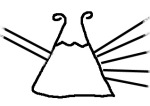Its Friday the Thirteenth… I wonder what Neil would say.
Thanks, Dr. Tyson. On to the science. (Don’t forget to do some superstition bashing today!)
Wow. I’m behind by a whole week, and have a meetup to go to tonight, so this is going to be mostly links.
Paleontology
Via RDF, a fossil of Australopithecus sediba has been found at the Malapa Site in the Cradle of Humankind in South Africa.
Geologists in Peru are working to preserve a 3.6 million year old “whale cemetery” containing at least 15, probably more fossil whales killed by a volcanic ashfall. Most of the preservation work will be to prevent erosion of the fossils due to exposure to harsh wind driven sand.
Fascinating examination of a fossil bird showing traces of various elements left over by the mineralization process. The copper present is likely to be from the eumelanin pigment, giving hints regarding the color pattern of this 120 million year old bird.
A fossil of an early bird egg has been found (these are pretty rare, apparently) and is shaped like a modern oval egg. This is similar to the egg shape of the therapod dinosaurs, from which it is thought that birds evolved.
I find myself wishing a case of diptheria on the people that destroyed a hadrosaur fossil at an Alberta dig site. Apparently, some idiots have made a habit of destroying the fossils while drinking. Don’t do that.
Anthropology
Bog bodies are strange, but this bunch of quasi-bog bodies is really weird. An articulated skeleton made from multiple bodies, buried for reasons only guessed at.
Via AmericaBlog, an interesting DNA study regarding the origins of Native Americans. This study suggests that three migrations from Siberia acted as the founding populations.
Medical science
The HPV vaccine may already be having an effect on herd immunity, with infection rates dropping in unvaccinated groups.
REM sleep behavior is one of my favorite sleep disorders, since I have yet to find any suggested link between it and the paranormal. Sleepwalking, night terrors, sleep paralysis… they all get blamed on ghosts, ghoulies, and aliens, but not this one. And it seems to have some link to neurodegenerative disorders in a majority of the cases.
Bicycling is fun, and I don’t get to do it nearly as much as I would like to… but knowing how to fit your bike properly is important. In fact, it can affect your sexual health.
What happens if you “get spaced” or “cold shirt it?” Your vacuum questions answered here. (I regularly get asked this one by students. It feels good to be right.
Genetics
Are we teaching genetics properly? Are we bogged down in the history of the science so much that we ignore the state of the art? It is beginning to look like it. If you are as interested in evidence based teaching as much as I am, you should read this and the paper that goes with it. Better course design = better courses.
Zoology
I’m sure you have seen this by now, but a shark stole this young woman’s fish! But did you immediately know what shark it was? Bull sharks swim upriver, in fresh water, for as much as hundreds of miles, so being in a coastal wetland is nothing out the ordinary.
Perfume often includes whale puke. Bleah. But some people are working on a substitute made from the product of a basalm fir gene.
Clam tongue? No. Clam foot. Call it whatever you want, I’m still not eating it.
Wonderful photos of the wee animicules of the ocean
Just the other day, I thought I heard cicadas. I did! I did! Brood I is out, and despite being in an area that has had almost all of its old trees removed and replaced with young trees, I was surprised to hear any at all. Cicadas live underground on tree roots for so long that removing the trees can put a real kink in their reproductive cycle. Go and see the great video at Bug Girl’s place.
Evolution
“What Darwin Didn’t Know” is a pretty good documentary on evolution and is now available online. Check it out.
The demise of evolution in the textbooks of South Korea was wildly incorrect. A short piece in one book that was scientifically incorrect was removed and is going to be updated. This was trumpeted in the world media as a complete removal of evolution… and nobody checked the sources. Always check your sources.
Botany
A new species of plant in the British Isles has been discovered. It resulted from the hybridization of two related invasive species, and is significant because speciation in the wild is not something we usually get to observe.
Antarctic moss finds an unlikely nutrient source. Ancient penguin poop.
Carnivorous plants do some neat things. This one “eats” nematodes. By eat, I mean kills and absorbs the nutrients from.
Environmental science
Excellent video on global warming / anthropogenic climate change. Not too long to use up a whole class period, but a good way to start discussion.
If we cut our CO2 levels now, will the oceans stop rising? Yeah, not so much. There is lag time between CO2 release and the effects that it has on climate.
Overexploitation of natural resources such as fisheries is a major problem for the environment. 30% of fish stocks are overexpoited, which will make it more and more difficult to make a living from fishing and can drive species to the brink of extinction, if not right over the edge.
Is the current batch of extreme weather events due to global warming / antropogenic climate change? We have to be careful making statements regarding this. Weather isn’t climate. Short term events are not long term trends. So, what we really need to do is take a look at what has been predicted based on climate models. Does this fit with those predictions? Yes. Is it likely due to global warming? Very likely. Should we be careful in our phrasing and how we talk about climate’s relationship with weather? Absolutely (although I think MarkCC is a bit hard on Phil). Sad thing is, nuanced discussion doesn’t go over with the media very well and is weak in the face of a lie told with certainty.
Good news, authorities in the Philipines (hello to my readers in the Philipines!) seized 1500 fish and 150 pieces of live coral bound for aquariums.
Physics
Why do non-Newtonian fluids act like they do? Physics. Its like three dimensional chain mail, becoming rigid under impact, The suspended particles are pressed together and form a structure that resists the pressure. Make some ooblek, play with it, teach.
Keep an eye out for Nobel prize winning physicists on street corners giving impromptu explanations of science.
Tech
Did you see Prometheus? Those cool LIDAR mapping probes that mapped the ruins, making a map that the lost scientists apparently didn’t use… That technology exists now.
Classroom
Can iPads be used as teaching tools? Apparently so. Hopefully, this technology can be put into a slightly less expensive tablet.
Getting undergrads used to reading scientific literature is a goal that every college and university STEM department should have. Here is one way to approach the challenge.
Everybody loves XKCD, right? Of course. And XKCD has given us a tool to describe how the eyes work.

